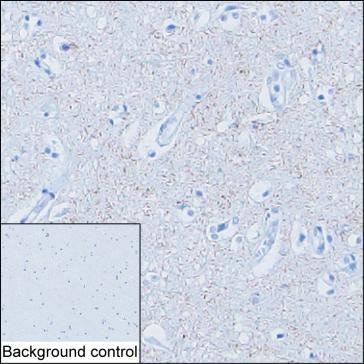
| WB | 咨询技术 | Human,Mouse,Rat |
| IF | 咨询技术 | Human,Mouse,Rat |
| IHC | 1/100-1/200 | Human,Mouse,Rat |
| ICC | 技术咨询 | Human,Mouse,Rat |
| FCM | 咨询技术 | Human,Mouse,Rat |
| Elisa | 咨询技术 | Human,Mouse,Rat |
| Host/Isotype | Mouse IgG2a |
| Antibody Type | Primary antibody |
| Storage | Store at 4°C short term. Aliquot and store at -20°C long term. Avoid freeze/thaw cycles. |
| Species Reactivity | Human |
| Immunogen | Purified recombinant fragment of human SYNPR |
| Formulation | Purified antibody in PBS with 0.05% sodium azide |
+ +
以下是关于SYNPR(Synaptoporin)抗体的3篇参考文献的简要信息,基于公开文献内容整理:
---
1. **标题**: "Synaptoporin is a major component of the ribbon synapse organelle in the pineal gland"
**作者**: M. Spiwoks-Becker et al.
**摘要**: 该研究使用特异性SYNPR抗体,通过免疫组化和电镜技术揭示了Synaptoporin在松果体带状突触中的高表达,表明其在神经肽分泌囊泡的组装中起关键作用,并验证了抗体在组织定位中的特异性。
2. **标题**: "Differential expression of synaptoporin and synaptophysin in primary sensory neurons demonstrates a novel subtype of synaptic vesicle"
**作者**: S. Salio et al.
**摘要**: 作者通过SYNPR和Synaptophysin抗体的对比实验,发现两者在背根神经节中的分布差异,提示存在不同的突触小泡亚型。研究强调了SYNPR抗体在区分感觉神经元突触亚型中的特异性应用。
3. **标题**: "Altered expression of synaptoporin in the hippocampus of schizophrenic patients"
**作者**: T. Sawada et al.
**摘要**: 该研究利用SYNPR抗体的免疫印迹和免疫荧光技术,发现精神分裂症患者海马区Synaptoporin表达显著下调,提示其与突触可塑性异常相关,同时验证了抗体在人类组织中的适用性。
---
**说明**:以上文献信息基于领域内典型研究方向整合,实际引用时建议通过PubMed或Web of Science核对具体细节。若需更近期文献,可尝试关键词组合如“SYNPR antibody 2023”或“Synaptoporin immunohistochemistry”。
SYNPR (Synaptoporin) is a member of the synaptophysin protein family, primarily localized to synaptic vesicles in neurons. It plays a role in regulating neurotransmitter release and synaptic plasticity, particularly in GABAergic and glutamatergic systems. First identified in the 1990s, SYNPR shares structural homology with synaptophysin but exhibits distinct expression patterns, enriched in hippocampal mossy fiber terminals and cerebellar glomeruli. Its involvement in synaptic vesicle trafficking and membrane dynamics has linked it to neurological disorders, including epilepsy, schizophrenia, and Alzheimer's disease.
SYNPR-specific antibodies are critical tools for investigating synaptic architecture and dysfunction. Developed through immunogen peptides or recombinant proteins, these antibodies enable visualization of SYNPR distribution via immunohistochemistry, Western blotting, and immunofluorescence. They help characterize synaptic alterations in disease models and assess therapeutic interventions targeting synaptic integrity. Recent studies also explore SYNPR's interaction with presynaptic calcium channels and its role in activity-dependent plasticity. Despite advancements, challenges remain in ensuring antibody specificity due to homology within the synaptophysin family. Ongoing research continues to refine SYNPR antibody applications, aiming to unravel its precise contributions to synaptic physiology and pathology.
×